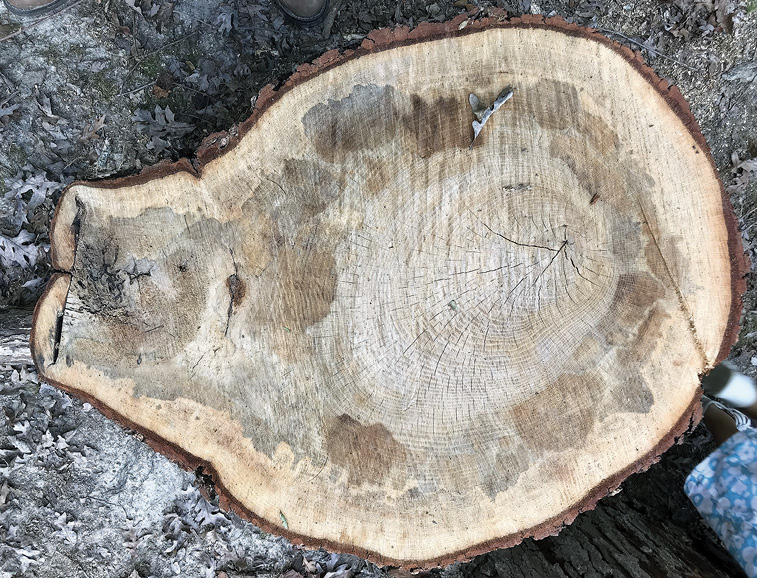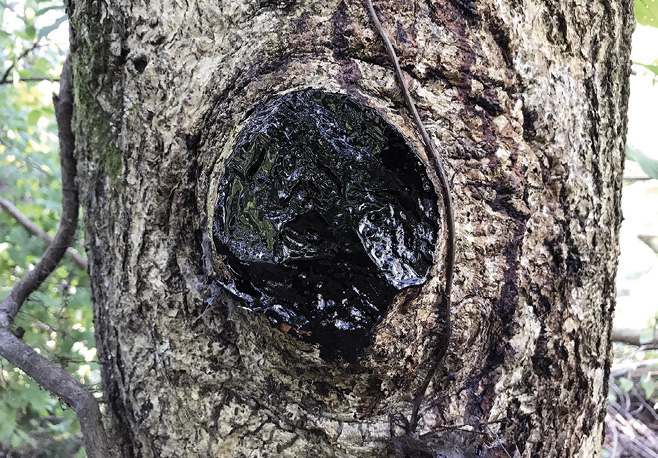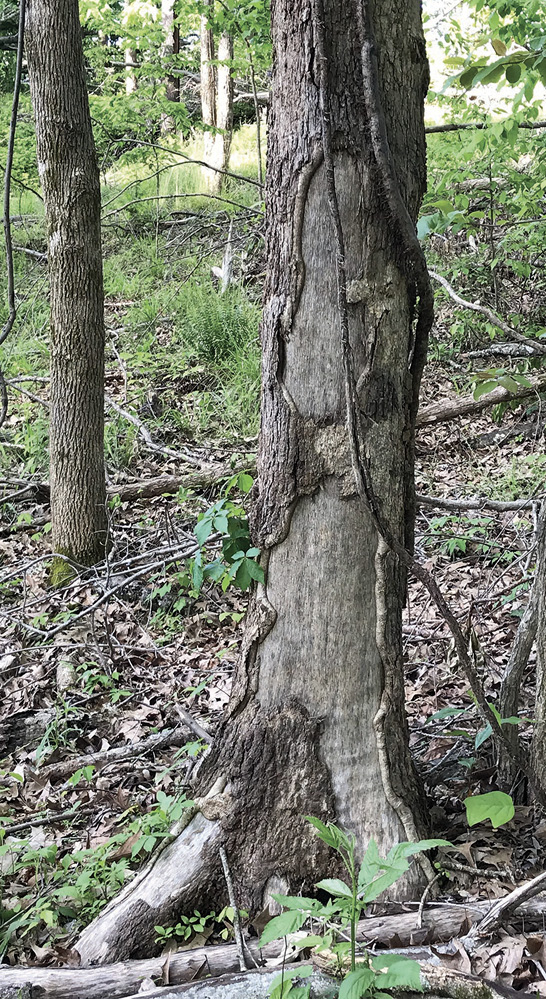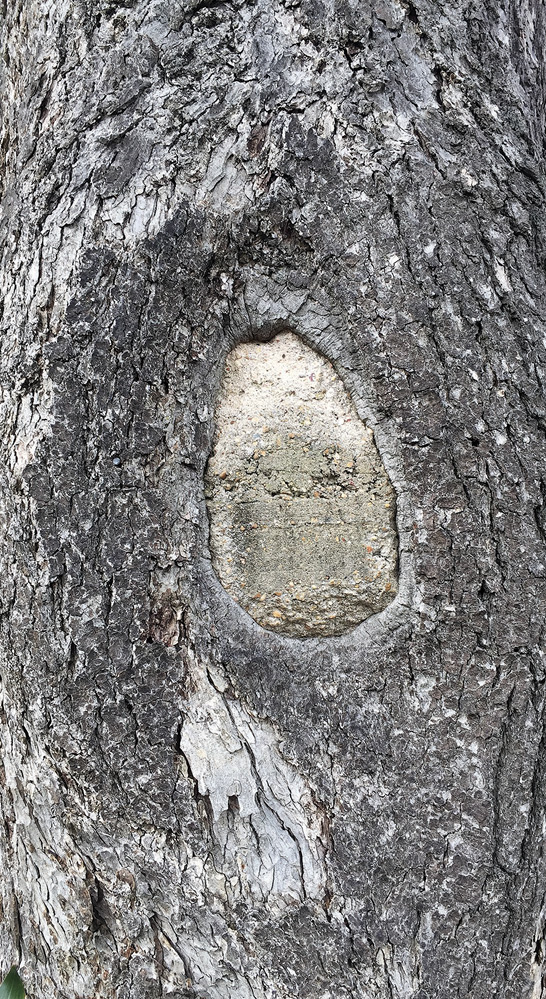Tree Wounds: Should They Be Repaired?

Trees in urban and landscaping settings are more likely to receive wounds compared to trees in natural stands. These wounds can be caused by accidental contact with automobiles, construction equipment, or lawn equipment that damages the trunk or surface roots. Tree wounds can also occur through intentional treatments like pruning, as well as natural processes such as storms, fires, and animal damage.
When a wound penetrates the bark and damages the cambium (a thin layer of vascular tissue responsible for water and nutrient movement within a tree), it also exposes the interior of the tree to damaging organisms such as fungi and bacteria. Once the tree has been wounded, these organisms can enter heartwood and begin the process of decay. Decay results in discolored wood and structurally weakened and/or unattractive stems with shortened lives. For this reason, recommendations are often made to apply some sort of wound covering to help the tree recover. However, decay cannot be reversed, and these measures are typically futile and negatively inhibit a tree’s natural sealing processes.
A tree responds to wounds by compartmentalizing and forming suberized (cells take on a sealing function), lignified (strengthened) wood known as callus tissue that prevents entry of pathogens. Callus tissue develops at the edge of wounds and grows toward the center. This new wood remains for the life of the tree, overlying the wound, and it limits further spread of decay. The positive benefits of compartmentalization do not stop with closing off damaged tissue. While the process is not well understood, trees also create chemical boundaries around infected cells that continue to react to pathogens, thereby further confining damage. After these processes have occurred, decay will not spread unless something breaks the barrier.
Should Tree Wounds Be Repaired?
Broken Limbs, Splits, and Physical Repairs
Weather events, impacts from lawn/construction equipment, and abrasion from falling trees often result in physical damage to tree limbs and boles. In these cases, broken limbs can be cut in a manner that avoids bark stripping. It may be possible to repair smaller split branches or trunks with a variety of techniques used by arborists. Wounds with ragged torn bark should have loose bark removed and the rough edges smoothed by cutting with a saw, knife, or chisel. For more information on physical repair methods, please consult Mississippi State University Extension Information Sheet 1355, Repairing Storm-Damaged Shade, Ornamental, and Fruit Trees.

Wound Dressings
Historically, many people recommended treatment of tree wounds. Usually, the recommendation involved applying tree paint. We now know that covering wounds with paint is detrimental, but some continue to recommend the practice, and tree wound products are still marketed. Many of these products are petroleum-based—tar, asphalt, paint—and serve only to impede callus tissue formation and successful compartmentalization. These products also seal in moisture, which prevents drying and encourages decay. In addition, some of these products can actually be used as a source of food for fungi. In most cases, tree wounds can seal themselves and should be allowed to go through the natural processes described earlier.


Filling Cavities
As with applying wound dressings, filling cavities in trees was an accepted practice at one time. For cosmetic purposes, cavities would be cleaned and scraped down to undamaged wood and filled with cement, mortar, bricks, or similar materials. These processes typically broke the tree’s physical and chemical compartmentalizing barriers and allowed decay to continue unimpeded. The appropriateness of filling cavities depends on several factors.
In cases of small cavities, it is usually best to allow the tree’s natural defensive processes to seal the cavity. Larger cavities may never seal over; however, they may not be a problem if the tree is able to successfully compartmentalize the wound and further damage does not occur. Some research has shown that filling large cavities can provide a surface for callus tissue to attach and prevent in-roll as it grows inward. However, filling cavities is typically costly, does not stop decay, and often results in rupture or abrasion of the boundary that separates decay and sound wood. Therefore, it is cavity cleaning—not necessarily filling—that often results in further damage to the tree. If it is necessary to fill a cavity, callus tissue that has formed must not be damaged.

Pruning Wounds
It is very common to see trees with structural damage that resulted from improper pruning in urban areas. Proper techniques should be used to remove dead, dying, broken, low, hazardous, or otherwise undesirable branches. Pruning places some stress on trees by reducing photosynthetic capacity when food-producing leaves are removed (if limbs are living). It also creates wounds that require the tree’s resources to seal and guard against entry by disease and insects.
Pruning cuts should be performed in a manner that maximizes chances of a tree’s natural sealing abilities. Cuts should be smooth and clean; they should not leave stubs and should maintain the branch collar. A branch collar is the swollen area where the branch attaches to the trunk. Cutting above the branch collar results in a smaller area that callus tissue must cover. Additional information on pruning technique can be found in Mississippi State University Extension Information Sheet 204, Pruning Landscape Plants.
Suggested Reading
Bachman, G. R. 2018. Repairing storm-damaged shade, ornamental, and fruit trees. MSUE Information Sheet 1355. 4p.
Clatterbuck, W. K. 2006. Tree wounds: response of trees and what you can do. UT Extension Publication SP683. 4p.
Denny, G. 2017. Pruning landscape plants. MSUE Information Sheet 204. 4p.
Shigo, A. L. 1982. Tree health. Journal of Arboriculture 8(12): 311-316.
Shigo, A. L., and W. C. Shortie. 1983. Wound dressings: results of studies over 13 years. Journal of Arboriculture 9(12): 317-329.
Publication 3533 (POD-09-23)
By Brady Self, PhD, Associate Extension Professor, Department of Forestry.
The Mississippi State University Extension Service is working to ensure all web content is accessible to all users. If you need assistance accessing any of our content, please email the webteam or call 662-325-2262.




